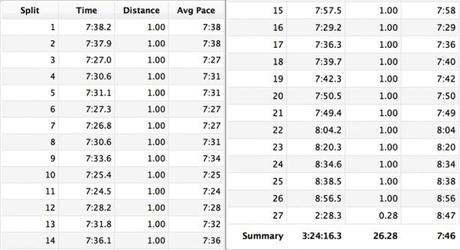Why couldn’t Pheidippides have died at 20 miles?
– Frank Shorter
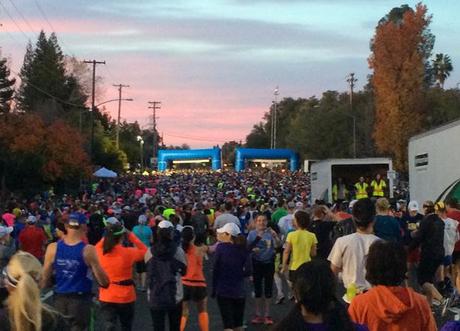
“Go!” time in Folsom
The sun awoke in the eastern sky over Folsom to find a captive audience waiting. Six thousand or so brightly clad disciples all faced toward mecca, in this case the state capitol in Sacramento and the finish line of the 32nd California International Marathon. Rosy tendrils peeked through wispy cloud cover above the start line porta-potties, bathing the compression-clad and KT-taped congregation in muted light. And here, as I parted the sea of 6,000 fellow runners to line up alongside the 3:25 pacer, I felt strangely relaxed. Curiously comfortable. And right where I belonged – like a Twinkie in a fat kid.
I was looking forward to CIM as what I hoped would be the star atop my 2014 racing tree. Not that I’d done much to advance that agenda – my five weeks since New York City had basically amounted to one long taper, with no legit speed work and no long run over 16 miles.
But it was the past two weeks that had me most concerned, a 14-day whirlwind of skipped meals and skewed sleep patterns leading up to the public launch of RaceRaves just 120 hours before race day. The timing was unfortunate but unavoidable, and it enabled me to arrive at the CIM start line having launched a website that Katie and I (objectively) feel is already among the best online resources for runners to find, discover, rate, review and organize their races. Now, as the expressive female vocalist nailed the “la-AND of the FREEEEEE” as all good National Anthem singers should, I was hoping the training I’d banked for Berlin and NYC would cover for my recent self-neglect.
Of course, Berlin and New York might be part of the problem rather than part of the solution. Having run two fast-ish marathons in the past 70 days I was more or less daring my legs to revolt, to suddenly up and decide “We’re good, see you in 2015!” On the bright side, I hadn’t flown 5,800 miles across 9 time zones to be here as I had for Berlin, nor even so much as the 2,500 miles across 3 time zones we’d traveled for New York’s 50,000-person, five-boroughs party. So maybe home-field advantage would play in my favor today.
I could’ve debated endlessly the pros and cons of running CIM, but Steve Jobs said it best: the only way to find out what’s possible is to try. (In Northern California it’s de rigeur to ask, WWSD – What Would Steve Do?)
So here I was in Folsom, about to find out what was possible. Three factors had prompted me to give CIM another shot after a memorable PR effort (at the time) with several friends back in 2011: 1) I had no races scheduled in December; 2) we’d be in the Bay Area that weekend anyway for our nephew’s 7th birthday; and 3) CIM has an exclusive October registration window for runners chasing a Boston qualifying time.
Normally CIM sells out several months before its early December race date; however, the race organizers now offer post-sellout registration in October to prospective Boston Marathon qualifiers who have recently completed a marathon within 10 minutes of their Boston qualifying time. Granted I’m biased, but this BQ late-registration window is a cool idea that more race directors should and probably will emulate to attract runners.
For me, my current Boston qualifying time is 3:15:00 (although next year it downshifts to 3:25:00) – so having run a 3:24:14 in Berlin, I qualifed for this late registration window. Despite the increased registration fee, I opted to sign up with a “what the heck, we’ll be in the neighborhood anyway” mindset.
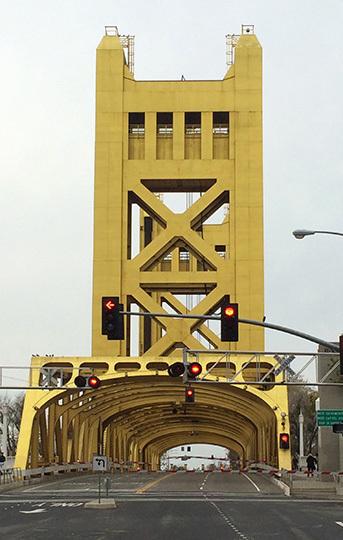
The Tower Bridge, a Sacramento landmark
Start to mile 20: Easy peasy…
Despite the hopeful inclusion of the word “International” in the race name, the word “California” does precede it for good reason – based on pre- and post-race conversations, the field now streaming under the dual blue starting arches would be largely Californian, with little of the global flair of my previous two marathons.
As my final 26.2-mile journey of 2014 began on an immediate downhill trajectory, I savored the sparse crowds and the cool, crisp Northern California air. Weather-wise this would be a perfect day for a group run with 6,000 friends, as the groggy sun had already renewed its morning slumber, leaving a pallid overcast sky to watch over us.
The elbow room all around me stood in (elbow joke!) sharp contrast to New York City, which reminded me of a stat I’d heard at the race expo on Saturday: whereas New York last month had hailed its one millionth finisher in its 44th year, on this day CIM in its 32nd iteration would celebrate its 100,000th finisher. Turns out this was Ann Mueller, appropriately a Sacramento native who finished in 4:45:56 and received a VIP Entry Package for CIM 2015 for her efforts.
The smaller field size is a key reason CIM comes highly recommended, particularly for those hunting that elusive BQ prey. No doubt the organizers at the Sacramento Running Association (SRA) could greedily squeeeeeeze a few thousand more runners into the start line area, or institute a corral system with different waves and start times. Rather than chasing the $$$, though, the SRA has chosen to keep the field size small and manageable, which to my mind significantly improves the race experience.
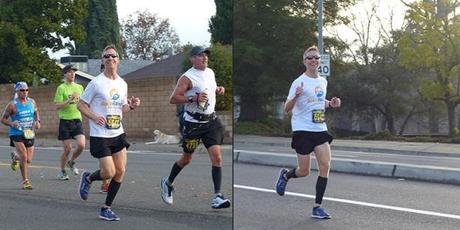
Feeling just like heaven at miles 6 and 11
The other main selling point of CIM is the course layout – and this is a good time to mention that this race report is brought to you by the word “net”. As in, the organizers trumpet CIM as a net downhill course beginning at 366 ft and finishing at 26 ft above sea level. Which is absolutely true – only the shortest distance between those two points isn’t a straight line.
CIM has no shortage of rolling hills, particularly in the first half and more specifically in miles 8, 11, 12 and 13. These hills are noticeable, though none were severe enough to affect my pace, and in fact I appreciated the rolling terrain for the respite it afforded my hip flexors. Berlin’s crazy-flat course may allow for fast times, but running on invariably flat asphalt can lead to discomforting tightness caused by recruiting the same muscle groups in the same way for 26.2 miles. So I actually found myself appreciating the brief up and down stretches in the first half of CIM, which reminded me of the three wine country races I’d run in the Bay Area and Santa Barbara.
I’d calculated my ideal 5K splits and wore them taped around my wrist. On Dan’s advice I’d planned to track them in lieu of mile pace times, though I soon realized the course lacked regular 5K markers (these would be a nice addition next year, especially as the race continues to woo BQ wannabes). At any rate, this just didn’t feel like a “live by the watch, die by the watch” type of race. Instead, I monitored my early mile times to avoid doing anything stupid, and after finding my rhythm resolved to run as comfortably hard as I could for as long as I could – while keeping the 3:25 pacer in my rearview mirror.
The one conspicuous downside to CIM is the (lack of) scenery. The 20 miles that separate Folsom from Sacramento are best described as “nondescript” – nondescript suburban roads passing an endless procession of nondescript strip malls. Orangevale, Citrus Heights, Fair Oaks and Carmichael – civic planners could rearrange these towns in any random order, and even their residents would be hard pressed to tell the difference. Like trying to tell Santa’s first eight reindeer apart. CIM is suburban America… but with that monotony comes a sense of inner calm I can’t get running through an urban juggernaut like Chicago, L.A. or New York.
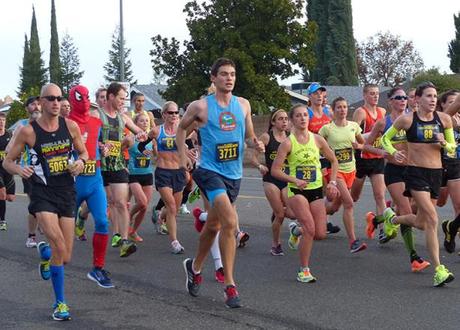
Fighting crime can be tough for a super-hero living in the suburbs, with no tall buildings to swing from
Given the sameness of scenery, I focused instead on the spectators – the older fellow sporting a white tutu, the ram mascot in a “Volunteer” t-shirt, the tiny future runners gleefully lining the street with hands extended, hoping to earn a sweaty high-five for their troubles. For those with their own cars, CIM is an easy course to spectate – as in 2011, Katie stayed north of the course and had no trouble catching me at miles 6, 11 and 18. This ease of spectating was nowhere more apparent than for the ubiquitous woman I saw at three different locations waving a sign that read, “It’s a 10K with a 20-mile warmup!” I nodded in agreement, not realizing how prescient her sign would be.
Cowbells jangled, spectators cheered and the instantly recognizable electric-guitar chorus of “Do You Wanna Dance?” (more Ramones than Beach Boys) greeted us as the miles ticked off. Another tree-lined neighborhood, another gas station, another Subway sandwich shop. Eat fresh, Citrus Heights. Eat fresh, Fair Oaks. Eat fresh, Carmichael. Two spectator signs stuck in my head, the first for its much-appreciated candor (“Keep going! You’re NOT almost there!”) and the second because its esoteric message hit too close to home (“Run like your thesis depends on it!”).
On race day my stomach is typically my canary in the coal mine, and the earliest predictor of rough seas ahead. So when it staged its first mild protest sometime after mile 10, I was chagrined but hopeful it would quiet down enough to let me reach the finish line. But the collywobbles only got worse, forcing me into a pitstop immediately after mile 14. Up to that point I’d been cruising along comfortably at a roughly 7:30/mile pace, and this was my first indication that the machine I was operating might be less finely tuned and not as well-oiled as I’d hoped.
That, as it turns out, was an understatement.
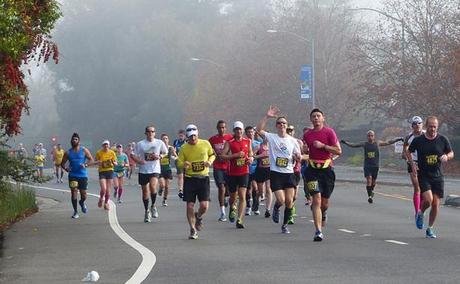
Trying to hail a cab at mile 18, while the fellow behind to my left primes for takeoff
Mile 21 to finish: … can I stop now, pleasey?
Mile 20 of the marathon represents The Wall – not the Pink Floyd version, but that juncture in the race when unreplenished carbohydrate stores start to dwindle. In the case of CIM, mile 20 also doubles as the gateway to Sacramento – here suburban sprawl gradually gives way to progressively taller buildings and more narrow streets.
The marathon relay at CIM draws a huge number of runners, and soon after the mile 20 marker we passed the third and final relay exchange point of the afternoon. Like the first two, this one was raucous and alive with the anticipation of restless runners awaiting their incoming teammates. Several relay runners blasted past me out of their chute (meep! meep!), presumably fueled by the raw adrenaline of knowing less than 6 miles separated them from the finish line.
Mile 21, and though everything typically slows down 21 miles into a marathon, I’d reached the 20s feeling strong and in solid position for another PR.
And then…
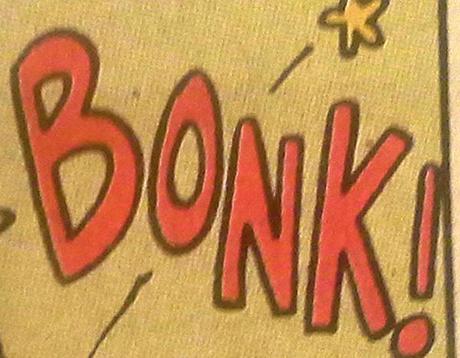
I wish I could explain what happened next. I wish I could put my finger on why the well ran dry, why the engine ran out of steam, why I started writing in metaphors. Maybe those two whirlwind weeks leading up to race day were to blame. Maybe it was the hubris of trying to fit just one more fast marathon in at the end of the racing season. Or maybe it just wasn’t my day (though what that means scientifically speaking, I’m not sure).
Nothing about my pre-race or race-day routine had changed. I’d topped off my carbohydrate stores the night before, eaten the same granola-yogurt-peanut butter concoction I eat before every race, and even started popping Shot Bloks earlier in the race than usual, just in case. Who knows, maybe it was this routine that ensured I even made it to mile 21 at all.
In any case, what happened next wasn’t pretty, it wasn’t funny, and it was unlike anything I’ve experienced (on the roads, anyway) since my rookie marathon at Long Beach over four years ago. I just kept… slowing… down.
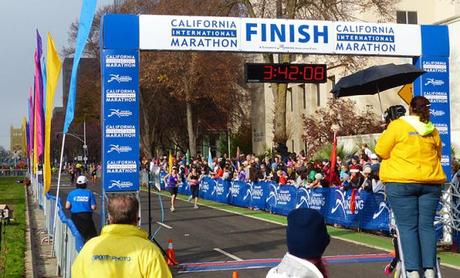
This welcoming scene couldn’t come soon enough (the Tower Bridge can be seen in the background)
As we crossed the J St. Bridge over the American River and into urban Sacramento, mile 22 became my first 8:00+ mile (8:04). And if the net downhill of the next four miles were a movie, it would be “Slow and Slower”. At no time during this stretch did I glance at my Garmin… what was the use? It wasn’t as though I was holding something back, carefully pacing myself until the clouds parted and the “Chariots of Fire” theme resonated from the heavens, inspiring a finisher’s kick that was lying in wait, like a coiled snake, just waiting to strike.
Mile 23 passed in 8:20.
My entire focus shifted to simply not stopping. Not on trying to maintain pace or even speed up in the face of escalating fatigue, but on a goal as basic as moving forward. So much easier writ than done. In Berlin my brain had tried unsuccessfully to persuade me that 22 (or 23, or 24) miles was plenty, and that I deserved a walking break – hey slow down, take in the city, when will we be back in Berlin? But at CIM, even more than my brain it was now my body urging me to pull over and take a well-deserved breather.
Mentally I shifted focus, assessing my body head to toe, scanning for any sign of an ally in this battle. Hey, my ears still felt pretty good. So did my teeth. And with my shoes tied much less tightly than in Berlin, the tops of my feet could easily knock out another ten miles, at least.
Mile 24 crept by in 8:34.
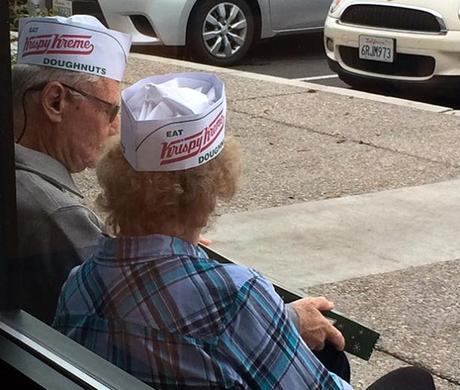
We interrupt this downward spiral for a sweet slice of Americana, seen during our lunch stop
There comes a point in every marathon where spectator support takes the form of blatant lies. An earnest fellow to our left hollered, “You’re having so much FUN!!!” Honestly, I’m having +/- ZERO fun.
From the other side of the road came another shout: “You’re all making this look so EASY!!!” Are you watching the same race I’m running?
Mile 25 trickled by in 8:38.
Strong-legged, relaxed-looking runners floated past me on either side, looking like gazelles bounding past the sick member of the herd who would ultimately become dinner for some lucky lion. Something wasn’t right here, something was definitely out of place, why – then it hit me. Relay runners. I felt a spike of relief knowing I hadn’t missed out on some magic speed-restoring elixir at the last aid station.
Less than a mile to go. I am actually going to finish this. Has the 3:25 pacer passed me yet? Glad I don’t have to watch myself right now, my form feels awful. Glad I don’t have to watch myself ever, how boring would that be? Poor Katie. No check that, lucky Katie, she’s waiting at the finish. Next time will be different. #lessonlearned. Did I just hashtag my thoughts? My teeth are starting to hurt.
Mile 26 oozed by in 8:56, and looking back at my splits, I claim as a moral victory the fact that I kept this final mile under 9:00.
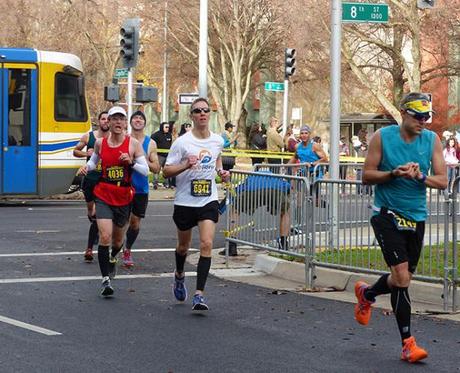
Floating toward the (men’s) finish line on the final turn
I kicked in the jets for the final stretch, covering the last 0.28 miles at a breakneck 8:47/mile pace. I could feel myself crossing the center line as my stride degenerated and a feeling of light-headedness washed over me. By the time I crossed the finish line (men to the right, women to the left, a CIM exclusive), I had no idea what news – good or bad – my Garmin held in store for me. As the spots in my field of vision dissipated, I exhaled and glanced down at my wrist.
3:24:16. Official time 3:24:15 – one second slower than my Berlin PR.
I’d just run 26.2+ miles – the last five feeling like a water buffalo, and the last 20 without glancing at my watch once – and missed my PR by a single second. Insult to injury, my Garmin congratulated me on my best marathon time ever, having clocked an unofficial 3:24:17 in Berlin.
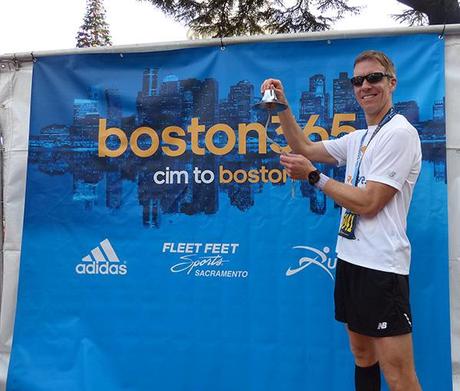
Damn right I’ll ring that Boston bell, every chance I get
As I thanked the teenage volunteer for my medal, a frenzy of conflicting emotions flooded my head. Should I be pleased with my second-fastest marathon ever? Or frustrated by not having taken advantage of a cool day on a fast course? Pleased that I’d qualified twice for Boston in less than 70 days? Or frustrated that I hadn’t nailed down a more convincing BQ the second time? (if you’re confused by what it means to “qualify” for Boston, see my Berlin Marathon report). Both emotions heated my blood and frayed my nerves . And as I write this I still feel very much… plustrated.
Drifting through the finish chute wrapped in my heat sheet, I emerged in front of the capitol building where I reunited with Katie – always the best part of any race. We wandered the finish area around a fenced-off Christmas tree, appreciating the small-town feel and snapping our traditional finish-line photo, a photo we’d been unable to take in either Berlin or New York. No doubt, it felt good to be home.

Celebrating a capital day in the capitol city
Later, at our niece’s basketball game, our newly 7-year-old nephew asked to see the CIM medal that, in our haste to get back from Sacramento in time, still hung around my unshowered neck. He turned it over in his hand. “Did you win?” he asked.
I thought about his question, and about my day. The promising first 20 miles, followed by a final 10K that left me crossing the finish line with a head like a helium balloon. Another golden opportunity to nail down a Boston qualifier, sabotaged by a convergence of events that left me unable to properly respect the marathon distance. Yet at the same time, a near-PR effort and an inarguable performance given the circumstances… although I hate the phrase given the circumstances.
No doubt time will recalibrate my warped perspective. It’s easy to take a disappointing race personally, to imbue it with far more meaning than it deserves. Truth was, I’d wrung a lot out of my body in 70 days – I’d slammed into two (figurative) walls 5600 miles apart and in both cases kept pushing, refusing to concede as every myofiber and brain cell screamed at me to call it quits and walk it in. Truth was, 2014 was the year I made the 3:25 marathon my new norm, and set the bar even higher for 2015. Truth was, CIM was all part of a process that couldn’t (and wouldn’t) be rushed. And the truth was, I couldn’t rationally argue with the day I’d just had, no more than I could with the earnest little boy now sitting in my lap.
“Yeah,” I responded, his small but strong heels bouncing off my shins. “I guess I did.”
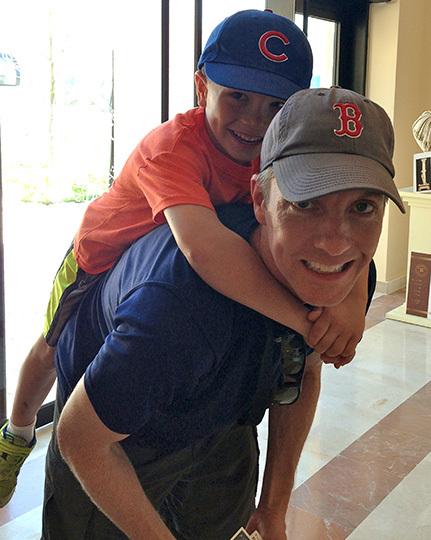
He’s a tough little critter to shake
BOTTOM LINE: Six letters to sum up six pages: run CIM. The organizers bill their marathon as the “fastest, friendliest, most spectacular course in the West!”, and they may well be 2/3 right. Suburban monotony notwithstanding, the net downhill course is PR-friendly and offers just enough variety (i.e. hillage) in the first half to keep the legs guessing. From its readily navigated expo to its easy start line access to its cowbell-toting spectators, CIM is a first-class marathon that doesn’t sacrifice its relaxed, small-town vibe. The field size (5,805 finishers this year) is very reasonable, not to mention fast – my 3:24:15 placed me in 997th place. Spectators and musical entertainment along the course maintain the low-key feel of the race, being supportive but not oppressively so. And weather conditions have been ideal both years I’ve run, although December typically is the rainy season in Northern California (a reality Jen experienced first-hand in 2012).
For runners looking for a year-end marathon in the first week of December, I wouldn’t hesitate to recommend either CIM (if you’re partial to roads) or The North Face Endurance Challenge Championship in SF (if you’re partial to trails). Both are terrific, well-produced races.
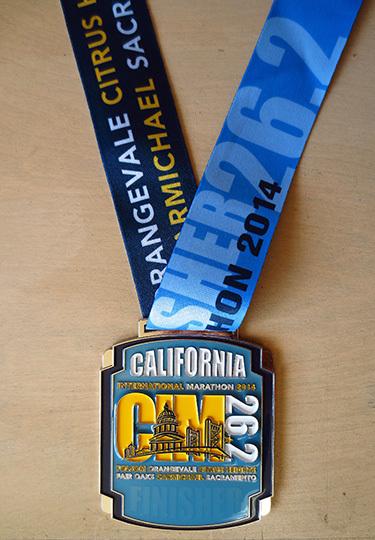
PRODUCTION: Don’t be fooled by its lack of bells (except cowbells) & whistles – race production for CIM is among the best you’ll find anywhere. And though there’s never a perfect race, clearly the SRA puts a lot of hard work into chasing that goal.
Take my 40-minute journey from hotel (in nearby Rancho Cordova) to starter’s pistol: Katie drove me ~15 minutes to the start-line shuttle pickup point, where I hopped aboard one of the last departing shuttles at 6:40am, arrived at the start line at 6:50am, made a quick pitstop at one of the abundant porta-potties (more proof of CIM’s keen attention to detail – porta-potties nearly as far as the eye can see), surrendered my drop bag and lined up alongside the 3:25 pacer by the time the National Anthem faded on the breeze. Now THAT’S customer service.
The race’s late-registration window for BQ wannabes is, to my knowledge, another CIM exclusive. This is a pretty genius idea on the SRA’s part, one I’d anticipate other race directors adopting in the not-too-distant future.
SWAG: This year’s shirt is a nicely designed, dark blue long-sleeve cotton tee and admittedly one of the few race t-shirts I’ll wear with any regularity after race weekend. And the finisher’s medal is a stylish periwinkle-and-gold souvenir with the capitol building and Tower Bridge emblazoned across a gold “CIM”. All in all, a nice collection of parting gifts.
RaceRaves rating:
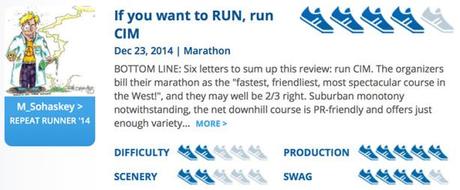
FINAL STATS:
December 7, 2014
26.28 miles from Folsom to Sacramento, CA
Finish time & pace: 3:24:15 (second time running the California International Marathon), 7:46/mile
Finish place: 997 overall, 146/552 in M(40-44) age group
Number of finishers: 5,805 (3,231 men, 2,574 women),
Race weather: cool and cloudy (starting temp 48°F)
Elevation change (Garmin Connect): 317 ft ascent, 654 ft descent
